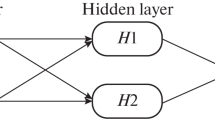Abstract
Given today's trend towards globalisation of markets, on-line quality control of manufacturing processes is deemed essential. We describe the use of neural networks and chaos theory to implement the idea of intelligent integrated diagnostics (IID) for this purpose. Our efforts are specifically concentrated on implementing IID in the turning process — a ubiquitous manufacturing process. We propose and develop two types of chaotic neurons — neural network architectures trained to capture the underlying chaotic dynamics of the turning process — to address the common problems of tool wear and chatter. The first, called the fractal estimation continuously estimates tool wear; the second, called theCOPAVAS, initiates optimal chatter control.
Similar content being viewed by others
References
Y. Koren, “Flank wear model of cutting tools using control theory”,ASME Journal of Engineering for Industry 100(1), pp. 19–26, 1978.
Y. Koren and E. Lenz, “Mathematical model for flank wear while turning steel with carbide tools”,CIRP Proceedings on Manufacturing Systems 1(2), pp. 127–139, 1972.
E. Usui, T. Shirakashi and T. Kitagawa, “Analytical prediction of three dimensional cutting process”,ASME Journal of Engineering for Industry 100(4), pp. 236–243, 1978.
J. J. Park and A. G. Ulsoy, “Methods for tool wear estimation from force measurement under varying cutting conditions”, in K. Danai and S. Malkin (ed.),Automation of Manufacturing Processes, ASME Press, New York, pp. 13–22, 1990.
J. J. Park and A. G. Ulsoy, “On-line flank wear estimation using an adaptive observer and computer vision. Part I: Theory”,ASME Journal of Engineering for Industry 115(1), pp. 30–36, 1993.
J. J. Park and A. G. Ulsoy, “On-line flank wear estimation using an adaptive observer and computer vision. Part II: Experiment”,ASME Journal of Engineering for Industry 115(1), pp. 37–43, 1993.
S. V. Kamarthi, S. R. T. Kumara and P. H. Cohen, “A review of model and observer based tool wear estimation methods in turning”, Submitted toInternational Journal of Production Research, 1996.
S. V. Kamarthi, S. R. T. Kumara and P. H. Cohen, “A review of neural network based tool wear estimation methods in turning”, Submitted toInternational Journal of Production Research, 1996.
S. T. S. Bukkapatnam, A. Lakhtakia and S. R. T. Kumara, “Analysis of sensor signals shows turning on a lathe exhibits low-dimensional chaos”,Physical Review E,52(3), pp. 2375–2387, 1995.
S. T. S. Bukkapatnam, S. R. T. Kumara and A. Lakhtakia, “Fractal estimation of flank wear in turning using time-delay neural networks”, in C. H. Dagli, L. I. Burke, B. Fernandez and J. Ghosh (ed.),Intelligent Engineering Systems Through Artificial Neural Networks, ASME Press, New York, pp. 575–580, 1994.
A. Goldberg, “Applications of wavelets to quantization and random process representations”, PhD. Thesis, Department of Electrical Engineering, Stanford University, Stanford, 1992.
I. Debauchies, “The wavelet transform, time-frequency localization and signal analysis”,IEEE Transactions on Information Theory 36(5), pp. 961–1005, 1990.
D. Donoho, “De-noising by soft-thresholding”,Technical Report: Department of Statistics, Stanford University, Stanford, 1992.
L. Liebovitch and T. Toth, “A fast algorithm to determine dimensions by box-counting”,Physics Letters A,141(8/9), pp. 386–390, 1989.
H. Stark and J. Wood,Probability, Random Processes and Estimation Theory, Prentice-Hall, Englewood Cliffs, NJ, 1994.
F. Koenigsberger and J. Tlusty,Machine Tool Structures, Oxford University Press, 1970.
S. A. Tobias,Machine Tool Vibration, Wiley, New York, 1965.
I. E. Minis, E. B. Magrab and I. O. Pandelidis, “Improved methods for the prediction of chatter in turning. Part III: A generalized linear theory”,ASME Journal of Engineering for Industry 112(1), pp. 28–35, 1990.
T. Delio and J. Tlusty, “Use of audio signals for chatter detection and control”,ASME Journal of Engineering for Industry 114(2), pp. 146–157, 1992.
R. Teltz and M. A. Elbestawi, “Hierarchical knowledge-based control in turning”,ASME Journal of Engineering for Industry 115(1), pp. 122–132, 1993.
M. Shiriashi, K. Yamanaka and H. Fujita, “Optimal control of chatter in turning”,International Journal of Machine Tools and Manufacture,31(1), pp. 31–43, 1991.
Z. Mei, S. Yang, H. Shi, S. Chang and K. F. Ehmann, “Active chatter suppression by on-line variation of the rake and clearance angles in turning — Principles and experimental investigations”,International Journal of Machine Tools and Manufacturing,34(7), pp. 981–990, 1994.
S. T. S. Bukkapatnam, A. Lakhtakia and S. R. T. Kumara, “Chaos theory based optimal cutting tool chatter control”,Speculations in Science and Technology,19(2), pp. 137–148, 1996.
S. T. S. Bukkapatnam, A. Lakhtakia and S. R. T. Kumara, “The concept of chaos theory based optimal cutting tool chatter control”, in B. O. Nnaji and K. C. Lau (ed.),Proceedings of SPIE 2595 Machine Tool, In-Line, and Robot Sensors and Controls, Philadelphia, PA, pp. 2–10, 1995.
I. Grabec, “Chaotic dynamics of the cutting process”,International Journal of Machine Tools and Manufacturing 28(1), pp. 19–32, 1988.
S.T. S. Bukkapatnam, S. R. T. Kumara and A. Lakhtakia, “Dependence of computed trajectory on step-size in nonlinear dynamic systems: An investigation into cutting tool dynamics”,IIE Transactions 27(4), pp. 519–529, 1995.
T. Kohonen, “Self-organizing maps”,Proceedings of IEEE 78(9), pp. 1464–1480, 1990.
Author information
Authors and Affiliations
Rights and permissions
About this article
Cite this article
Bukkapatnam, S.T.S., Lakhtakia, A. & Kumara, S.R.T. Chaotic neurons for on-line quality control in manufacturing. Int J Adv Manuf Technol 13, 95–100 (1997). https://doi.org/10.1007/BF01225755
Issue Date:
DOI: https://doi.org/10.1007/BF01225755




